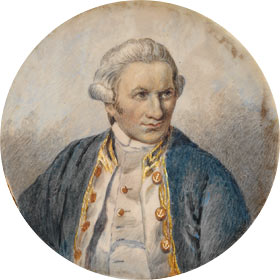Captain James Cook's voyages of discovery
Captain James Cook (1728-1779) was born in Yorkshire. At the age of about 17, Cook joined the merchant navy in the coastal town of Whitby and spent his apprenticeship and early career working on trading ships along the English coast and in the Baltic. After 10 years in the merchant navy, Cook entered the Royal Navy, and showed an aptitude for surveying, mapping and navigation. He honed these skills in military conflicts against France but his talents had been noticed by the Royal Society, which was keen to send British ships to the Pacific for research and exploration purposes.
Captain James Cook's three epic voyages to the South Seas, between 1768-1779, transformed the way Europeans viewed the Great South Land and the Pacific Ocean.
James Cook's first Pacific voyage (1768-1771) was aboard the Endeavour and began on 27 May 1768. Cook's first goal was to establish an observatory at Tahiti to record the transit of Venus, when that planet passed between the earth and the sun, on 3 June 1769. The second aim of the expedition was to record natural history, led by 25-year-old Joseph Banks. The final secret goal was to continue the search for the Great South Land.
The continued search for the legendary Great South Land also motivated Cook's second Pacific voyage (1772-1775). This voyage aimed to establish whether there was an inhabited southern continent in what we now know as Antarctica, as well as making astronomical observations.
> Find out more about Cook’s second Pacific voyage
Cook's third and final Pacific voyage, (1776-1779), was as important for exploration of the North Pacific as the earlier two had been for the South. The voyage aimed to find a north west passage between the Atlantic and Pacific Oceans. In the process, Cook made the major discovery of the Hawaiian Islands in January 1778. During the same voyage Cook was killed on a return visit to Hawaii at Kealakekua Bay, on 14 February 1779.
> Find out about the death of the Captain Cook in Hawaii during his third voyage of exploration





